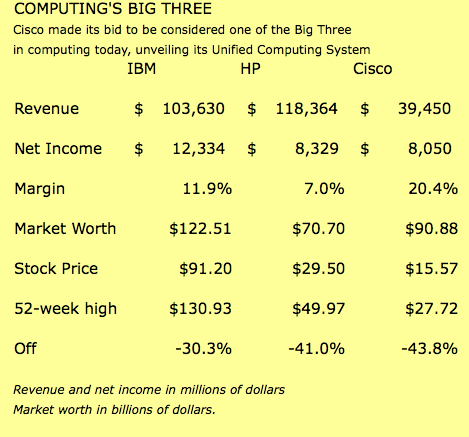Cisco launches bid to capture the data center

Cisco Systems has just launched what it considers a "critical step" in its Data Center 3.0 strategy, promising an ecosystem of partners which include chipmaker Intel, tech consultancy Accenture, virtualization software provider VMWare, Microsoft, the labs unit of enterprise software firm SAP, storage maker EMC and roughly two dozen other companies.
"The best technology doesn't always win.'' said Cisco CEO John Chambers. "I've always been technology-agostic,'' contending this group would work on services that extended from the data center not just to the office, but the home as well.
Also see: Cisco's big data center plans: Assessing winners and losers rack by rack
The Unified Computing System is Cisco's bid to take IBM and HP head-on in gaining entry and control of corporate data centers, through the use of virtualization and other technologies that consolidate the use of thousands of servers, applications and other resources. Right now, Cisco is a much smaller company in terms of revenue and has built most of its business on supplying network gear that connects data centers together (See chart).
But it now wants to be the behind-the-scenes coordinator of cloud computing, allowing "any application, at any time" to be delivered anywhere, said Rob Lloyd, executive vice president designate, Worldwide Operations for Cisco.
Chambers said that Cisco doesn't enter markets that it doesn't believe it can create some kind of "differentiation" that will lead to long-term leadership. He said the UCS "platform" would give Cisco and its partners access to roughly 25 percent of data center spending that could not be reached before. He called it a "multibillion dollar opportunity."
Whitepapers: Cisco Unified Computing System - At-A-Glance
• Cisco UCS B-Series blade servers based on the future Intel Nehalem processors and intended to allow "signficantly more virtual machines per server."
• 10-gigabit-per-second Ethernet connections, through local area networks, storage area networks and high performance computing networks. This is designed to reduce the amount of network adapters, switches, cables and pieces of cooling gear.
• Virtualization services, backed by Cisco security, policy enforcement and diagnostics.
• Storage access that ties together both storage area networks and network attached storage, using high-speed fibre channels and other connections.
• Management through both a graphical and command line interface in a product called Cisco Unified Computing System manager. This is designed to let IT staff manage all data center resource and automate provisioning of new services.
• Planning, design and implementation services, to conduct pilots or execute new services.
The initiative of course is also designed to sell Cisco hardware, as well. The company, as part of its attempt to unify data center operations, wants to be the glue that connects companies' investments in existing gear from other suppliers.
As part of that, Cisco rolled out three new pieces of its Cisco Nexus family of switches, including the Nexus 7018 modular siwtch that can support up to 512 10 gigabit Ethernet ports, the Nexus 5010, with 28 ports; and the Nexus 2000 "fabric extender," which is designed to increase the overall number of servers in a data center and the amount of bandwidth each can handle. Its Cisco Catalyst 6500 switch was recast as a "virtualized service node,'' to help accelerate applications.
"This is perhaps the only evolutionary road,'' that is feasible right now, said Paul Maritz, the chief executive of VMWare, that could lead to "revolutionary" new forms of computing.
For software developers, "our oxygen is really great hardware,'' he said. For storage maker EMC, the announcement was cast as "game-changing" in its ability to lower cost, increase data center scale and reduce complexity, by chairman Joe Tucci. The result should be greater "speed and efficiency."
The key here may be what BMC Software chief executive Bob Beachamp said would be the IT manager's ability to see, use and assign all resources in a data center from "a single pane of glass,'' i.e., single computer screen.
This is made possible, in theory, by virtualization, which provides a logical view of resources, rather than a physical view. In effect, a data center manager can see and regard all servers as a single pool of resources, with similar views on operating systems that are available, bandwidth that is available and able to be assigned and even applications, wherever they reside in reality.
Cisco, in its basic announcement, Cisco estimates its unification effort can cut capital spending on new hardware and software by 20 percent, reduce operating expenses in the data center by 30%, allow applications to be provisioned in minutes 'instead of days,' improve energy-efficiency and increase scale of operations without adding complexity.
In a corporate blog posting, Cisco specifically though tried to downplay the idea that it was "coming after IBM, HP or Dell."
It said:
We are not advocating going and doing a forklift upgrade or rip/replace on existing data centers customers have.
Instead, Cisco is trying to create a "subcategory of the server market" that will allow computing in a customer's own cloud to be unified.
The effort could stimulate spending in a flat market. IT spending in the U.S. is expected to be essentially unchanged this year from last.
"The money we unlock will be in the cracks between the siloes'' of computing that exist in many corporations' technology networks, Lloyd said.
